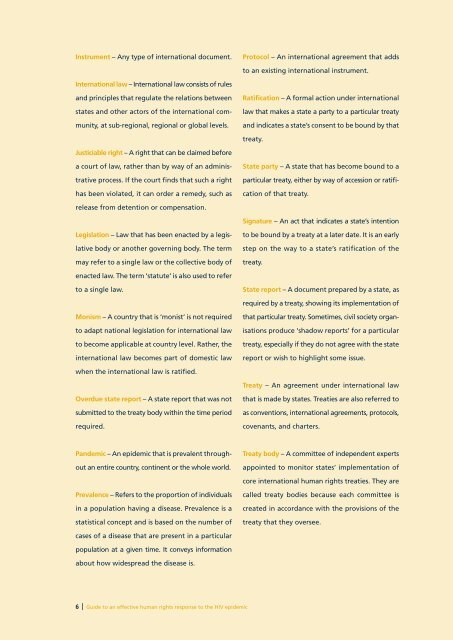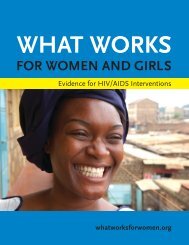Guide to an effective human rights response to the HIV epidemic
Guide to an effective human rights response to the HIV epidemic
Guide to an effective human rights response to the HIV epidemic
You also want an ePaper? Increase the reach of your titles
YUMPU automatically turns print PDFs into web optimized ePapers that Google loves.
Instrument – Any type of international document.<br />
Pro<strong>to</strong>col – An international agreement that adds<br />
<strong>to</strong> <strong>an</strong> existing international instrument.<br />
International law – International law consists of rules<br />
<strong>an</strong>d principles that regulate <strong>the</strong> relations between<br />
states <strong>an</strong>d o<strong>the</strong>r ac<strong>to</strong>rs of <strong>the</strong> international community,<br />
at sub-regional, regional or global levels.<br />
Ratification – A formal action under international<br />
law that makes a state a party <strong>to</strong> a particular treaty<br />
<strong>an</strong>d indicates a state’s consent <strong>to</strong> be bound by that<br />
treaty.<br />
Justiciable right – A right that c<strong>an</strong> be claimed before<br />
a court of law, ra<strong>the</strong>r th<strong>an</strong> by way of <strong>an</strong> administrative<br />
process. If <strong>the</strong> court finds that such a right<br />
has been violated, it c<strong>an</strong> order a remedy, such as<br />
State party – A state that has become bound <strong>to</strong> a<br />
particular treaty, ei<strong>the</strong>r by way of accession or ratification<br />
of that treaty.<br />
release from detention or compensation.<br />
Signature – An act that indicates a state’s intention<br />
Legislation – Law that has been enacted by a legislative<br />
body or <strong>an</strong>o<strong>the</strong>r governing body. The term<br />
may refer <strong>to</strong> a single law or <strong>the</strong> collective body of<br />
<strong>to</strong> be bound by a treaty at a later date. It is <strong>an</strong> early<br />
step on <strong>the</strong> way <strong>to</strong> a state’s ratification of <strong>the</strong><br />
treaty.<br />
enacted law. The term ‘statute’ is also used <strong>to</strong> refer<br />
<strong>to</strong> a single law.<br />
State report – A document prepared by a state, as<br />
required by a treaty, showing its implementation of<br />
Monism – A country that is ‘monist’ is not required<br />
<strong>to</strong> adapt national legislation for international law<br />
<strong>to</strong> become applicable at country level. Ra<strong>the</strong>r, <strong>the</strong><br />
international law becomes part of domestic law<br />
that particular treaty. Sometimes, civil society org<strong>an</strong>isations<br />
produce ‘shadow reports’ for a particular<br />
treaty, especially if <strong>the</strong>y do not agree with <strong>the</strong> state<br />
report or wish <strong>to</strong> highlight some issue.<br />
when <strong>the</strong> international law is ratified.<br />
Treaty – An agreement under international law<br />
Overdue state report – A state report that was not<br />
submitted <strong>to</strong> <strong>the</strong> treaty body within <strong>the</strong> time period<br />
required.<br />
that is made by states. Treaties are also referred <strong>to</strong><br />
as conventions, international agreements, pro<strong>to</strong>cols,<br />
coven<strong>an</strong>ts, <strong>an</strong>d charters.<br />
P<strong>an</strong>demic – An <strong>epidemic</strong> that is prevalent throughout<br />
<strong>an</strong> entire country, continent or <strong>the</strong> whole world.<br />
Treaty body – A committee of independent experts<br />
appointed <strong>to</strong> moni<strong>to</strong>r states’ implementation of<br />
core international hum<strong>an</strong> <strong>rights</strong> treaties. They are<br />
Prevalence – Refers <strong>to</strong> <strong>the</strong> proportion of individuals<br />
in a population having a disease. Prevalence is a<br />
statistical concept <strong>an</strong>d is based on <strong>the</strong> number of<br />
called treaty bodies because each committee is<br />
created in accord<strong>an</strong>ce with <strong>the</strong> provisions of <strong>the</strong><br />
treaty that <strong>the</strong>y oversee.<br />
cases of a disease that are present in a particular<br />
population at a given time. It conveys information<br />
about how widespread <strong>the</strong> disease is.<br />
6 | <strong>Guide</strong> <strong>to</strong> <strong>an</strong> <strong>effective</strong> hum<strong>an</strong> <strong>rights</strong> <strong>response</strong> <strong>to</strong> <strong>the</strong> <strong>HIV</strong> <strong>epidemic</strong>

















